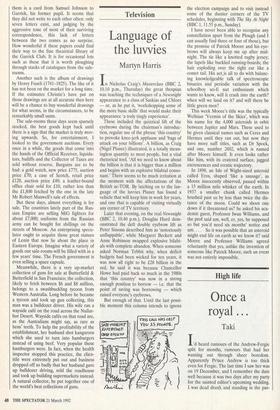Sale-rooms
Estate bottled
Alistair McAlpine
Well, it had to happen. The wines that the late Mr Robert Maxwell took home to his house in the country have come up for sale. This time, the sale takes place at Christie's. It is not a very remarkable cellar by any standard — not half as exciting as the cellar of the House of Commons that the late Mr Maxwell sold when he was chairman of the House's catering commit- tee. It was believed that he bought those wines himself, but there is no sign of them in this sale.
Reading through his catalogue, I wonder if Maxwell was really interested in wine at all. It is, a magpie's collection of bits and pieces, until you come to the wines from 1982. 'The 1982 vintage has always been a controversial one, and has caused much discussion and debate': so reads Christie's catalogue entry that precedes the next 145 lots. All this could have been said of the late owner of these wines, if indeed he did own them. The catalogue continues, 'Few, however, doubt its quality' — there is little doubt any longer about the quality of the late Mr Robert Maxwell — 'The greatest disagreement has been over whether a vin- tage which tasted so universally impressive so young, as the 1982s did, could continue to develop into the great long-lasting vin- tage which was being promised'. These bot- tles may well have belonged to the late Mr Maxwell but they are not Maxwelliana. If you feel like taking a punt on the 1982s, well, good luck to you. I was a seller of that vintage two years ago.
There is no sign in this sale of the vin- tage pink Dom Perignon which I know he possessed. The late Mr Maxwell offered it to a friend of mine who happened at the time to be working for him, with the words, `I don't suppose .that you have ever drunk this champagne before'. She had.
On Thursday Phillips sold the remaining papers of the late David Garrick. Amongst them is a card from Samuel Johnson to Garrick, his former pupil. It seems that they did not write to each other often: only seven letters exist, and judging by the aggressive tone of most of their surviving correspondence, this lack of letters between the two comes as no surprise. How wonderful if these papers could find their way to the fine theatrical library of the Garrick Club. It is for occasional lots such as these that it is worth ploughing through stacks of catalogues from the sale- rooms.
Another such is the album of drawings by Henry Fuseli (1741-1825). The like of it has not been on the market for a long time.
If the estimates Christie's have put on those drawings are at all accurate then here will be a chance to buy wonderful drawings for what seems, in the circumstances, to be remarkably small sums.
The sale-rooms these days seem sparsely stocked, the best goods kept back until there is a sign that the market is truly mov- ing upwards. So, for entertainment, I looked to the government auctions. Every once in a while, the goods that come into the hands of the Official Receiver, liquida- tors, bailiffs and the Collector of Taxes are sold without reserve. Bargains are to be had: a gold watch, new price £775, auction price £70; a case of Scotch, retail price £120, auction price £40; a leather-bound office chair sold for £10, rather less than the £1,800 fetched by the one in the late Mr Robert Maxwell's sale of effects.
But these days, almost everything is for sale. The countries lately part of the Rus- sian Empire are selling MiG fighters for about £7,000; uniforms from the Russian army can be bought for shillings on the streets of Moscow. An enterprising specu- lator ought to acquire those great statues of Lenin that now lie about the place in Eastern Europe. Imagine what a variety of goods our sale-rooms will be filled with in a few years' time. The French government is even selling a space capsule.
Meanwhile, there is a very up-market collection of guns for sale at Butterfield & Butterfield in San Francisco; the collection, likely to fetch between $6 and $8 million, belongs to a swashbuckling tycoon from Western Australia. Long before he became a tycoon and took up gun collecting, this man was a bulldozer driver. His wife ran a wayside café on the road across the Nullar- bor Desert. Wayside cafés on that road are, as the Australians might say, as rare as hens' teeth. To help the profitability of the establishment, her husband shot kangaroos which she used to turn into hamburgers instead of using beef. Very popular these hamburgers were. In fact, when the health inspector stopped this practice, the clien- tele were extremely put out and business dropped off so badly that her husband gave up bulldozer driving, sold the roadhouse and took up building supermarkets instead. A natural collector, he put together one of the world's best collections of guns.



























































 Previous page
Previous page